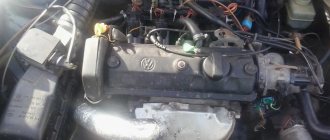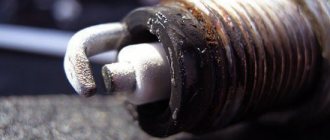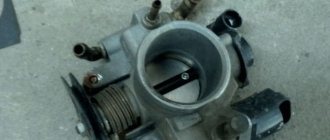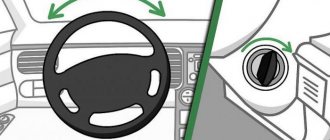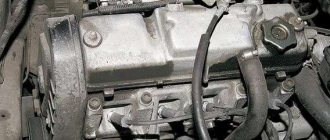Difficulties starting the engine “cold” arise in different situations. Firstly, leaving the car in the cold for a long time. This could be one night or several weekends. Secondly, the cooling of the internal combustion engine after it has warmed up to operating temperatures, stopped and attempted to restart after some time.
In DAAZ and Solex carburetors the following phenomenon can be observed: the engine starts, and after a while it stalls. If the spark plugs are flooded, then the starting device, or rather its diaphragm, is to blame for stopping the internal combustion engine. Let's look at common cases when problems arise with starting a carburetor-type engine.
- The starter spins the crankshaft, but “does not catch” (problems with fuel supply, no ignition).
- “Grabs”, but does not start the internal combustion engine (problems with ignition).
- The crankshaft does not spin (the battery is dead).
For owners of cars with carburetor internal combustion engines who encounter problems during cold starts, it is advisable to check possible fault locations in the following order:
- spark plug;
- wires (high voltage);
- starting device;
- idle jet;
- breaker contacts;
- ignition timing;
- fuel pump;
- vacuum booster tube.
There is another useful tip that will be useful to owners of domestic cars. Try to slowly (without jerking) press the gas pedal and turn the starter. Then release the gas to find the moment when the clutch “grabs”. To start the engine, keep the gas pedal in the found position until it warms up.
Injection engine does not start well
In cars with injection engines, the weak point is a variety of sensors. Their incorrect operation leads to difficult starting of the engine, since the ECU receives incorrect information. This remark is valid for the following types of sensors:
- throttle valves;
- fuel consumption;
- pressure sensor in the intake manifold (MAF).
In injection power plants, the coolant temperature sensor also affects the start. The thermistor sends data to the control unit containing information about the condition of the coolant. Incoming signals influence changes in the composition of the air-fuel mixture.
In injection-type engines, a common reason that the engine does not start when cold is that the fuel pressure regulator is at fault. If there are certain difficulties when starting the internal combustion engine “cold”, but the problems disappear after warming up, check the condition of the spark plug wires, the spark plugs themselves and the coils.
Leaky injectors cause many problems for car owners. Due to leaking fuel nozzles, the power unit has difficulty, but also after a certain time of operation (even in extreme heat outside). To test this theory, you can relieve the pressure from the fuel supply system before parking overnight, and look at the result in the morning.
Useful advice for owners of cars with injection engines. If there are no problems with the starter, fuel assembly ignition devices and wires, then you should look for the fault in the coolant sensor. It is also worth checking the pressure indicator in the fuel supply system.
Take care in advance
In general, in cold weather, the alarm system’s already weakened battery is additionally drained. If the car is stored in a guarded parking lot, it is better to leave it unguarded, thereby increasing the chances of starting in the morning. In order to open the doors without problems, you need to keep a can of a composition called “lock defroster” in your clothing pocket all winter. It costs a penny, but it helps a lot when the key refuses to even “go” into the hole. If you don’t have a defroster at hand, you’ll have to test the old-fashioned method for yourself - warm the key with a lighter.
By the way, if you inject the same defroster or WD-40 into the lock in advance of frost, practically no water gets there. Do not use brake fluid to dissolve ice or treat locks. The lock may open, but by the evening it will freeze again, because, unlike special fluids, the brake fluid does not repel water, displacing it from the lock. In addition, it easily damages car paint.
Also, in severe frosts at night you can go out to warm the engine. Or pay parking attendants to warm up your car overnight. If possible, place it in the garage. Even in an unheated room, the temperature is 5-7 degrees higher than outside. And these are “two big differences” – minus 27 or minus 20.
If you still can’t start, and you have enough time, then you can try to determine the composition of the fuel mixture. To do this, simply remove one of the spark plugs from the engine and inspect it. If there are black (or very dark) deposits, the fuel mixture is quite rich, which means that there is something wrong with the car’s ignition system. Most often, in such cases, it is enough to replace the spark plugs, and engine starting returns to normal.
If there is no dark carbon deposit on the removed spark plug or it is white, we are talking about a lean fuel mixture. In this case, the culprit of the problem is often the coolant temperature sensor. You will always have problems with this - you will have to replace it.
When the fuel mixture is lean, some car owners try to start the engine using various additives that increase the octane number of the fuel. Sometimes they succeed. Another method that is often used in this situation is the injection of ether compounds to start carburetor engines. However, dealing with depressurization of the intake tract in the cold, and then doing all this in the reverse order, is not a pleasant task.
Another reason for a lean fuel mixture can be insufficient fuel pressure in the system. There are mainly two reasons here. This is either a dying fuel pump or a fuel pressure regulator. If there is a problem with the fuel pump, it may be impossible to start the engine. But sometimes the fuel pressure in the system can be raised to the optimal level by plugging the drain hose by squeezing it. This must be done carefully, as it may burst in severe frost. After starting the engine, you should not continue to pinch the hose. Otherwise, there is a high probability that the spark plugs will be splashed with too rich a fuel mixture. If this happens and the engine stalls, allow the mixture to evaporate by waiting 5-10 minutes. Or clean the spark plugs.
The most common cause of problems starting a cold engine can be the usual depressurization of the intake tract. Most often we are talking about a slipped (sometimes burst) tube that connects the fuel pressure regulator in the system to the intake manifold. Carefully inspect the connections of all tubes (hoses, etc.) that go from the intake tract to other systems or elements (brake system, adsorber, crankcase ventilation, etc.), and if there are serviceable elements of the injection system, problems with cold starting on your car will not.
Tips for starting the engine in cold weather:
- Keep the tank full - this will prevent condensation from forming and water will not get into the fuel.
- Turning on the high beams for a couple of seconds before starting will restore some of the battery capacity on frosty days.
- After turning the key in the ignition switch (on an injection car), wait a few seconds until normal pressure is created in the fuel system, and only then start the engine.
- Pump up gasoline manually (on a carburetor car), but you must not overdo it, otherwise the spark plugs will flood.
- Cars run on gas, under no circumstances should you start them cold, switch to gasoline first!
Similar articles
Won't start on cold diesel
With the launch of diesel engines, other problems come to the fore. One of the main ones is weak compression. It is determined by the following signs: the car does not start on its own after a night in the cold (only from the pusher), a small dark gray smoke comes out of the exhaust system. The presence of the latter at the moment of cranking by the starter indicates the absence of problems with the fuel supply, but certain difficulties that arise when igniting the mixture.
In engine cylinders with low compression, the gaps between the elements increase. Therefore, it is problematic to start the engine “cold”. There is no pressure in the combustion chamber necessary to ignite the air-fuel mixture at the moment the internal combustion engine starts.
Why is this happening? First of all, you should check for severe wear or serious damage on the following parts:
- pistons and piston rings;
- cylinder walls;
- timing valve.
Low compression is a common occurrence on high mileage cars and trucks. Their owners are faced with the fact that the power unit starts with serious problems both in severe frost and in more favorable conditions. Problems with starting are also associated with low quality diesel, containing a large amount of impurities, and breakdown of spark plugs. If everything is more or less clear with fuel, then the glow plug does not function for various reasons:
- oxidation of the connection connector;
- relay malfunction.
Let's look at the second problem in more detail. The relay operating mode is controlled by a sensor that monitors the coolant temperature. If it is working properly, the driver hears clicks when turning the key in the ignition switch. If there is no characteristic sound, then the problem is clearly related to the spark plug relay.
If there is good compression, the engine will start in cold weather even with poorly functioning spark plugs. However, in the first minutes of engine operation, speed jumps will be observed.
Don't write off fuel injectors. Their severe wear or contamination interferes with the normal operation of the internal combustion engine. In some situations, the fuel filter is to blame for interruptions with a cold engine start.
The injectors can throw a large amount of fuel into the return line. This is only determined during the test.
The injector takes a long time to start due to the fault of DTOZhV what is the reason why the injector takes a long time to start? The problem can be caused by various reasons, because the engine takes a long time to start not only when cold, but also when hot. Could this mean that the starter rotation time has nothing to do with temperature or not?
Prevention of injector breakdowns
Why the injection engine does not start and how to eliminate possible problems is now known to all readers of our resource. However, it is better to avoid such breakdowns, so let’s pay attention to ordinary procedures that, if carried out systematically, will help minimize the risks of all malfunctions. The simplest but most effective prevention consists of the following measures:
- Firstly, refuel exclusively at proven gas stations and only with high-quality fuel. Remember that most fuel system and engine malfunctions are caused by dirty gasoline;
- Secondly, change all consumables on time and only with high-quality products. The most important thing is periodic replacement of all kinds of filters and engine oil;
- Thirdly, periodically check the main components of the machine for stability. The list of the latter, naturally, includes the injector, elements of the fuel system, ignition and engine;
- Fourthly, never neglect routine diagnostics of your car at a service station. Surprisingly, even a delay of a couple of hundred kilometers can cause serious damage, which previously could have been eliminated with very simple actions;
- And fifth, always operate your vehicle properly. That is, you do not need to overheat, overload or negatively impact your car in any other way.
Perhaps this is where the most important information on today’s issue has come to an end. We hope the material presented above was useful and provided answers to your questions. Good luck in operating and maintaining your car!
Source: swapmotor.ru
Symptoms
ATTENTION! A completely simple way to reduce fuel consumption has been found! Don't believe me? An auto mechanic with 15 years of experience also didn’t believe it until he tried it. And now he saves 35,000 rubles a year on gasoline! Read more" The approximate time that is considered long and during which the engine starts is 5 or 8 seconds. In this case, twitching is definitely observed in the first seconds of operation of the internal combustion engine. At times it seems that the engine is operating on only two cylinders, and not four.
If you press the accelerator before starting, the start will be faster. But at the same time, fuel consumption and engine warm-up time will increase until the speed drops to normal. Another inseparable companion of such a situation is black exhaust. Obviously, black smoke from the muffler directly indicates that the fuel is not completely consumed and remains in the cylinders.
Diagnostics
Diagnosis of why the car takes a long time to start the injector So, to determine the specific reason for the long start of the injection engine, you should start with a high-quality diagnosis. Usually, they check the compression in the cylinders. Its values must be within 12 atm for this to be considered normal. In this case, there should be no deviations between these indicators in each of the cylinders (maximum - 1 atm).
Then the spark plugs must be replaced. This will have an effect on the engine and it will now start much faster. However, if everything is not in order with the motor, then the normal starting time will last only 1-2 days.
Therefore, high-voltage wires should also be diagnosed. Diagnostics will make it possible to find out whether the cables have a breakdown, which is clearly visible by the spark coming out at night. This is done as follows: the car starts in the dark, at the same time you need to monitor which wire sparks.
The ignition coil also needs to be checked. Many experienced drivers do this: they install a known good and new module instead of the original one, then check the engine starting for several days. If everything is normal, the start-up does not take long - it means that the whole problem was in the bobbin (ignition coil).
If there are no changes, the test continues. This time you should test all filters, including the air filter. Next is checking and replacing all sensors and regulators.
Pay special attention to the mass air flow sensor. The next stage: testing various connections, checking the wiring for good contact, cleaning the masses and flushing the throttle assembly.
If nothing changes again, then it is recommended to check the engine fan relay. It often causes similar problems with starting on a fuel-injected internal combustion engine. You can test the relay if you remove the wire from the temperature controller installed on the thermostat.
The fan should turn on after these steps. However, after measuring the resistance value on a warm internal combustion engine, the system can produce low temperature data, although the temperature inside the engine is clearly more than 90 degrees. Why is there such a difference?
It turns out that this may well be a buggy DTOZH, which for some reason was not checked earlier. It must show the real coolant temperature, otherwise chaos will begin in the system, and it is not surprising that the engine takes so long to start.
Battery
The first thing you should look at is the battery. And it doesn’t matter whether we are talking about a hot injection engine or a cold one. It also doesn't matter at all how many valves it has. The batteries of all modifications of the VAZ model under consideration are of the same type.
To find out why the Lada does not want to start, open its hood and look at the battery indicator. If the latter is missing, measure the voltage with a tester - 11.5 volts will be normal. Lower readings indicate the need to charge. When this is not the reason, then look further. Be sure to check if the battery terminals are oxidized. If so, clean them with fine sandpaper.
About DTOZH
In general, power unit temperature sensors are the most important regulators of an injection engine. There are two of them on it. One is located directly in the cylinder head, it displays the temperature value on the instrument panel.
The second one is located in the thermostat, and provides data on the temperature of the control unit of the power unit. Based on the results obtained, the control unit regulates the fuel supply - it supplies more fuel to a cold internal combustion engine, and less to a hot one. In addition, it is the control unit that regulates the OZ, influences the ignition of the fuel assembly, and activates the coolant fan if the liquid temperature rises above 100 °C.
Obviously, with faulty DTOZh there will be difficulties in the operation of the motor. However, this applies more to the DTOZH, which provides information directly to the block. For example, if the DTOZH is faulty, it will give false values about a cold engine, although it is already boiling.
The supply of fuel to the cylinders will increase, because this is provided by the system. Let's say you drove for a long time, then stopped and went into a store. Now starting the power unit will cause obvious displeasure, since it will take a very long time to start due to data failures and oversaturation.
Why does the injector take a long time to start due to DTOZhO At the same time, the OZ, which is responsible for the ignition of the fuel assembly, which is clearly over-enriched, changes greatly. As a result, the fuel will evaporate intensively, and the concentration of gasoline in the fuel assembly will be so high that the mixture will hardly ignite due to the small amount of oxygen.
It was said above that when you press the accelerator pedal, the startup time will be noticeably reduced. Now it becomes clear why this happens. By pressing the gas, we add oxygen to the fuel assembly, and the fuel ignites faster.
Thus, by replacing a faulty DTOZh, you can solve not only the problem with long-term starting of the internal combustion engine, but also other difficulties relating to the process of engine operation and its cooling system. The engine, after replacing the faulty DTOZH, will add stability, throttle response and power.
The procedure for returning the car to “life”
Let's say you find yourself in circumstances where the injection engine starts poorly or refuses to do so at all. There is no need to hesitate in such a situation - it is advisable to immediately begin resuscitation procedures. If you don’t have time to figure out the exact reason why the car doesn’t start well, then you should quickly carry out the following algorithm of actions:
- First of all, we check the availability of gasoline and battery charge. Is there something missing? Fill it up and light it up. Let's try to start. If there is no result, proceed to the next step;
- Next, we quickly analyze under what circumstances the car malfunctions. If it takes a long time or is difficult to start when hot, we first check the spark plugs for overheating (light carbon deposits) and the functioning of the fuel system. Otherwise, when the car malfunctions both cold and hot, a more comprehensive approach is required. As a rule, the following procedures are sufficient: checking spark plugs, wiring the ignition system, assessing the operation of the injector and fuel system;
- Note that most motorists manage to solve the problem, so to speak, with little loss, that is, by implementing the actions described above. If you are not one of the lucky ones and your car still takes a long time, starts poorly or refuses to work at all, you will have to act globally. Here it is better to take the car to a service station or a convenient garage and check the compression, timing adjustment, clean the injector, assess the condition of the fuel system and ignition devices. If there are any malfunctions, they must, of course, be eliminated.
In general, there are no particular difficulties in repairing a non-starting injector. The main thing in the process of such work is to act competently, in accordance with the procedure and possible vehicle malfunctions described above.
DTOZh replacement procedure and timing
The procedure for replacing the DTOZh may differ depending on the car model. At the VAZ, to carry out the process, you need to prepare several tools, including the obligatory set of wrenches. According to the classic scenario, the coolant will have to be drained, otherwise replacing the DTOZH cannot be called correct. Although there are several replacement options that do not involve draining.
As mentioned above, one of the DTOZH is located in the thermostat. It screws in from the side. The second is located a little lower, wrapped in the cylinder head.
A little about the timing of replacement of DTOZH. If we are talking about a regulator that goes to the pointer, then it must be replaced at the very moment when the temperature values go astray. This is easy to check: for example, when the engine is cold, the coolant needle tends to the red zone or simply wanders.
This is an error and requires correction, i.e., replacement of the sensor.
In some cases, it also happens that it is not the regulator itself that is to blame, but the wiring or contact. You need to check everything, and only then decide whether to change it or not. Testing the wiring is also easy: the wires are disconnected from the DTOZH, the ignition is turned on and a short to ground is made. If the arrow jumps up, then everything is in order with the wiring.
The second DTOZH changes if the machine itself is not working properly. For example, the speed of a cold engine does not increase, but when it is hot it reaches a value of 1500 rpm. Fault number 2 can also be judged by the cooling fan, which turns on too early or does not do so at all.
Temperature controllers that have been removed are easiest to check. They must be immersed in boiled water heated to certain values, then connect an ohmmeter to measure the resistance coming from the DTOZH. Tired of paying fines? There is an exit!
Forget about fines from cameras! An absolutely legal new product - Traffic Police Camera Jammer, hides your license plates from the cameras that are installed in all cities. More details at the link.
- Absolutely legal (Article 12.2);
- Hides from photo and video recording;
- Suitable for all cars;
- Works through the cigarette lighter connector;
- Does not cause interference to radios and cell phones.
A car engine may have difficulty starting when cold under different conditions. Sometimes it happens that the car has been sitting in a garage or outdoors for quite a long time. A situation may also arise when the engine was running, then cooled down, but it does not start again.
Starting problems that occur on a cold engine may not appear at all during a hot start. When cold starting, it is also important to consider the ambient temperature in which you are trying to start the car. During cold periods, some elements simply freeze, so starting the engine in such conditions is simply impossible.
Measures to effectively start a car engine in winter.
With the onset of winter frosts, many motorists begin to have problems starting a cold car engine. Sometimes it is not possible to start the engine - the battery is discharged and you have to ask other drivers to “light it”, that is, start the engine from the battery of another car.
Such problems usually begin when the outside temperature drops to 15-20 degrees below zero, for example, when you need to start the car in the morning, after the oil in the engine has frozen and thickened overnight, and the battery is “weak” due to the low temperature, since in the cold all chemical processes in it slowed down.
If you manage to start the car, then in the future the engine will start easily, unless, of course, it cools down again during a long stay.
Why are there difficulties when starting the engine in winter?
Very often, the driver himself is to blame for the occurrence of such problems, who did not pay attention to properly preparing the car for frost and does not know some methods for starting the engine at low temperatures.
If the engine is filled with the appropriate engine oil recommended by the manufacturer of the vehicle for winter use, the engine is in good working order and correctly adjusted, the battery has sufficient electrical capacity and is fully charged, then there will be no problems with starting the engine.
But the skills of the motorist, his experience and ability, play no less important role than the technical condition of the car. Each car has its own characteristics when starting, and an experienced driver knows these characteristics of his car.
Of course, the most ideal option is to follow the instructions in the operating instructions, where all the steps to start the engine are described in detail, but sometimes a capricious engine, as they say: “instructions are not a decree,” then the experience that the driver gains after going through tests comes to the rescue and mistakes.
General rules for starting the engine in winter
Be that as it may, there are general rules that can be followed to solve the problem of starting the engine in cold weather.
1. For example, you can advise immediately before turning on the starter to turn on the high beam headlights for 15 - 20 seconds. Thus, the chemical processes in the battery are activated and it will turn the starter more quickly. At the moment of start-up, the headlights and other consumers of electricity that are not needed at the moment must be turned off.
2. In addition, before turning on the starter, fully depress the clutch pedal, thus disconnecting the gearbox from the engine - there is no need to load the starter, forcing it, in addition to the engine crankshaft, to also rotate the gears and gearbox shafts in thickened transmission oil. The pedal should be released smoothly only after the engine starts.
3. Do not turn on the starter for more than 10 seconds, otherwise the battery may be damaged. After each startup attempt, take a break of at least half a minute. If the engine fails to start 4-5 times, then stop trying to start and figure out why the engine does not start; most likely, this is due to some kind of malfunction.
4. Quite effective means that make it easier to start the engine at low temperatures are special, so-called “starting fluids”. Usually these are easily evaporating ether-based liquids in aerosol cans. This aerosol is injected directly into the air intake and if the engine is working properly, then its start is almost guaranteed.
However, do not overdo it with such fluids, as they intensively wash away the oil film from the cylinder walls, which leads to intense engine wear.
5. If all attempts to start the engine only result in the battery being completely discharged, then you will have to ask more successful drivers for a “light” from the battery. By the way, in this case it is advisable to have your own special wires for “lighting up”, since asking for wires from another driver will not be entirely tactful.
The “lighting up” process itself occurs as follows: the wires are disconnected from the discharged battery and the “donor” wires are connected to them. “Plus” is connected to the positive wire, and “minus” is directly connected to ground, preferably to the engine housing.
If you do not disconnect the discharged battery, then when it is connected to the “donor” battery, the battery capacities will be equalized, which in turn will discharge the “donor”.
If the car has an engine with an injection power system, then this cannot be done. When starting such engines, their battery is not disconnected from the on-board network.
Source
The main reasons for poor cold starting
There are several main reasons why starting a cold engine will be difficult or even impossible. To understand the cause of the malfunction, it is necessary to conduct a thorough diagnosis and localize the breakdown. First you need to check the battery, it is possible that it is completely discharged. Next, you need to check that the starter works and rotates the engine at the same speed. If you refuel with low-quality gasoline, this can also lead to the fact that your car’s engine will be difficult to start when cold.
Weak battery or oxidized terminals
The starter does not turn - this is another common problem. Its cause may be deposits or corrosion on the battery terminals or a dead battery.
Remember that the generator will not be able to charge the battery completely and from time to time it is advisable to charge it from the mains. This will help it not lose its capacity and increase its service life.
If you notice that the terminals have strange deposits on them, you should clean them and treat them with a special lubricant that will prevent a similar problem from occurring again.
Problems with fuel supply.
Problems with cold starting appear when there is no supply of combustible mixture (fuel). Fuel can be supplied in very small quantities or in very large quantities. When there is too much of it, the spark plugs will flood and fail. In some cases, fuel may be supplied normally, but ignition of the mixture in the engine cylinders themselves does not occur or does not occur in a timely manner.
Checking the fuel system must begin with checking the exhaust. If, when the engine is rotated by the starter, a small amount of smoke comes out of the exhaust pipe, this indicates that ignition processes are occurring and fuel is being supplied to the corresponding engine cylinders.
After this, you need to check the spark plugs. To do this, take the appropriate key and simply unscrew them. If they are filled with fuel, this indicates an excess of fuel in the cylinders. This may occur as a result of injector leakage or ignition failure. If the spark plug is completely dry, this indicates that fuel is not supplied to the cylinders at all. It is necessary to check the functionality (presence of spark) of all spark plugs. Poor supply of the fuel mixture to the cylinders may be due to clogged fine and coarse filters. A kind of coating may form on the injector nozzles, which prevents the normal flow of gasoline. Fuel supply may also decrease due to fuel pump failure. In most cases, the fuel pump simply does not create the required pressure. To eliminate this malfunction, it will need to be completely removed and disassembled to eliminate the causes.
It will also be necessary to check all fuel lines for cracks and other damage that could allow air to enter the fuel system. This can be easily determined by the leak locations.
Starter malfunction
If, when starting the engine, the starter makes one loud click and nothing else happens, in 100% of cases this is caused by problems in the module itself. One click indicates that charge is reaching the starter as the relay clicks. In this case, failure of the relay is excluded. The cause of the problem with the functioning of this module may be an unstable charge that reaches it. In this case, you should try to start the engine again, and repeat attempts at intervals of 20 seconds. Perhaps on the 2nd or 3rd try you will be able to start the car. If the engine still does not start, investigate the following potential causes of the problem:
- the starter bendix has failed;
- the retractor is broken;
- the main winding of the starter is broken;
- winding short circuit;
- brushes and bushings are worn out.
In the latter case, it is only necessary to replace the failed components.
In any case, regardless of the reason why this problem occurred, the first step is to inspect and check all contacts visible from the outside. Often the starter stops performing its functions normally due to weak contact in one or another node. An unstable charge is also a fairly common cause. In this case, you just need to repeat the attempt to start the engine several times. Most likely, after two or three attempts you will be able to start the engine, and a similar situation will not repeat during subsequent starts.
Even if you eventually managed to start the engine after some attempt, you should not consider the problem solved. Otherwise, at some point the car will simply stop starting and you will have to look for alternative ways to start the engine. You should not solve the problem by replacing the starter.
A car has long ceased to be a luxury. It’s hard to imagine life without a car these days. Many people drive a car every day and for any need - to work, study, dacha, shopping, on vacation. And that's why it becomes very bad when the car won't start. Plans are ruined, meetings are cancelled, people lose money!
We will look at situations where the starter works, but the car still does not start, another time. And now - about what to do if the starter on a Priora does not turn.
First, let's understand how a starter works and what its structure is. An electric motor with a gear that meshes with the engine flywheel and turns it when started. All this is hidden in a housing on which the solenoid relay is mounted. It is designed to move the gear and supply power to the electric motor.
When you turn the ignition key, current is supplied to the relay. Using an electromagnet, it is retracted, using a special mechanism, it moves the gear and starts the engine by closing the contacts. When the key is released, power stops being supplied to the magnet of the solenoid relay, the relay operates in the other direction and the contacts open. So, we know what the principle of operation of the starter looks like in general terms, so now it will be easier for us to understand why the starter does not turn on the Priora.
If you hear clicking sounds when you turn the ignition key and the lights on the instrument panel go out, it may be the battery. It needs to be checked, recharged, topped up with electrolyte or replaced. Is the battery OK? Then the situation becomes more interesting. Check the wires that come from the battery. If they get hot, check their contact with the battery. Remove them from the terminals, clean them, lubricate them (sometimes oxidation occurs) and install them back.
Check the connection between the ground terminal and the body. If necessary, clean this connection. Check the connection between the plus terminal and the starter. Determine if power is supplied to the solenoid relay from the ignition switch. To do this, you need to disconnect the connector from the relay, and turn the ignition key “to start” and measure the voltage at the connector.
The Priora starter still won't turn? Then you will have to remove it from the car and check it.
The removal procedure looks like this: disconnect the battery terminals, unscrew and remove the air filter, unscrew and remove the positive wire from the starter. Then disconnect the connector from the relay, unscrew the starter mounting nuts and remove it. We are already much closer to solving the question of why the Priora’s starter does not turn. Now we take the wires for lighting (crocodiles) and connect them with the negative wire of the battery and the starter housing. We connect the positive one to the relay connector, after which the gear should be activated and ejected forward. If not, change the retractor.
You can hook the negative wire to the starter housing, and the positive wire to the lower terminal of the solenoid relay. The electric motor didn't work? The culprit is most likely the motor brushes.
Problems with electronic sensors.
Modern gasoline cars are equipped with fuel injection systems that inject fuel electronically. These systems are equipped with many special sensors. If a breakdown occurs with one of these sensors, the corresponding signals will not be sent to the main control unit, as a result of which the engine will no longer start normally. First of all, you will need to check the following three sensors:
- DPRV sensor, which indicates the correct location of the camshaft;
- TPS sensor. It gives signals about the main positions of the damper;
- Mass air flow sensor, which indicates the air flow in the system.
Ignition problems
When faults appear in the ignition distributor, this can lead to the engine being difficult to start when cold. The essence of this malfunction is that the starter rotates the engine, but seizure does not occur and the fuel in the engine cylinders does not ignite.
It is very important to set the ignition timing correctly; for each make of car, this angle will have its own meaning. It is also worth checking the condition of the drive and timing belt, as well as adjusting the valve timing, if any. To check you will need special tools and devices.
Poor starting when cold: problems with engine compression
As a result of prolonged use of the engine, some of its elements may become unusable, as a result of which compression in the cylinders will begin to drop. An engine with low compression starts very poorly because all the gaps between the main parts in the cylinders increase significantly. This leads to the fact that the required pressure is not generated in the combustion chamber, which is necessary for starting.
The following reasons lead to poor engine compression:
- Cracks on the piston;
- Damaged piston rings;
- Wear of the engine cylinder itself;
- Burnout of valves.
In conditions with low temperatures, it is simply impossible to start an engine with poor compression when cold.
Oil too thick
As you know, diesel engines use a different lubricant than gasoline engines. However, this does not insure the car against difficult starts, especially in winter. As the temperature drops, the engine oil begins to thicken. Even with a charged battery, it will be difficult for the starter to turn the flywheel, and with it the crankshaft. Typically, diesel engines use motor oil with a viscosity of 15W-40.
When operating in extreme conditions, experts recommend lowering the bar to 5W-30. Thinner oil helps the crankshaft rotate more easily, which is especially important for an engine with lower temperatures.
Let's sum it up
In this article, we looked at the most basic reasons why an engine may have trouble starting when cold. As you can see, there are not so many of them. Therefore, it will not be difficult even for a beginner to independently determine where the malfunction lies.
First of all, check the condition of the spark plugs, injectors and contacts with sensors. If everything is normal, then you need to check the pressure that the fuel pump creates and the functionality of the sensors. As a last resort, if nothing helps and it is not possible to solve the problem yourself, contact a specialized service.
